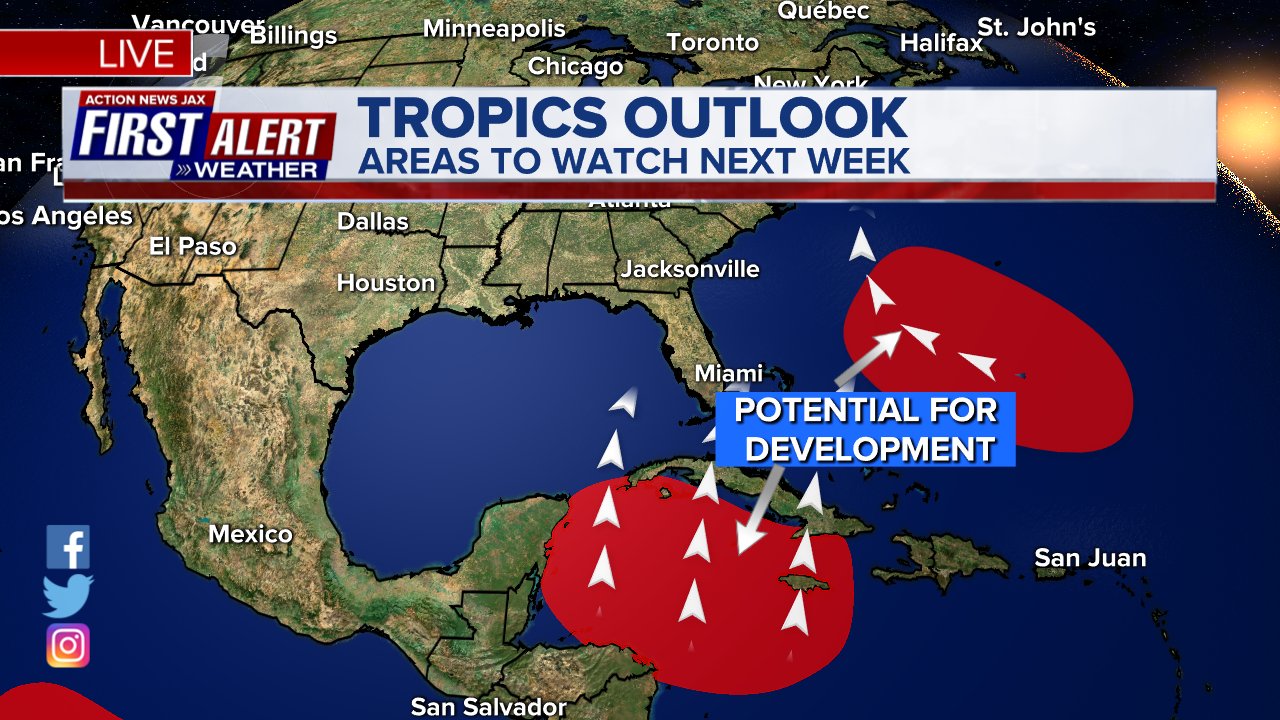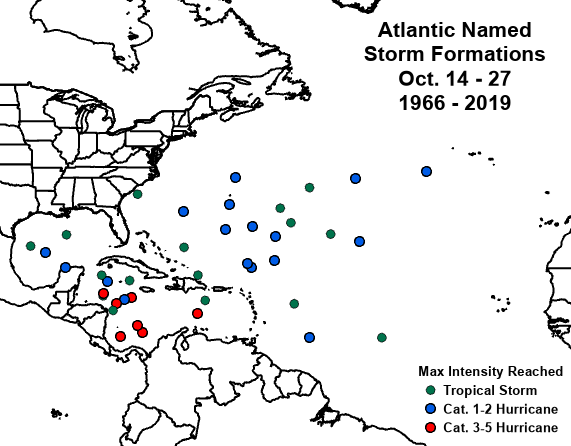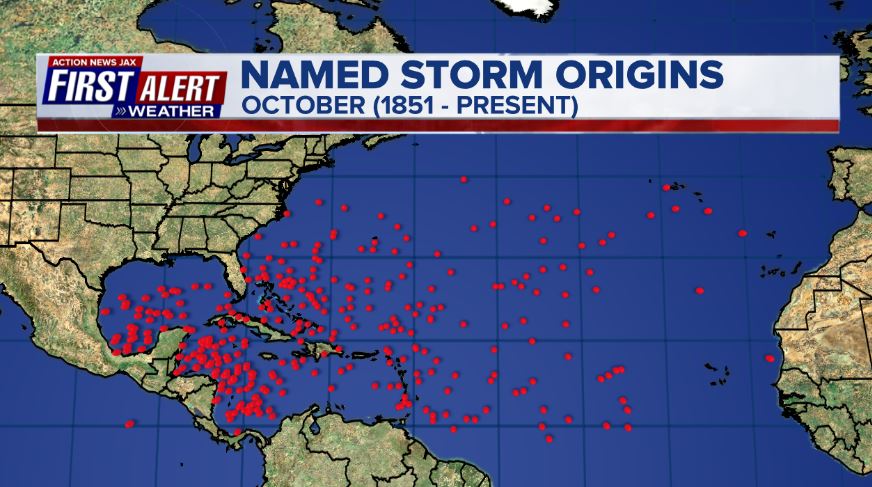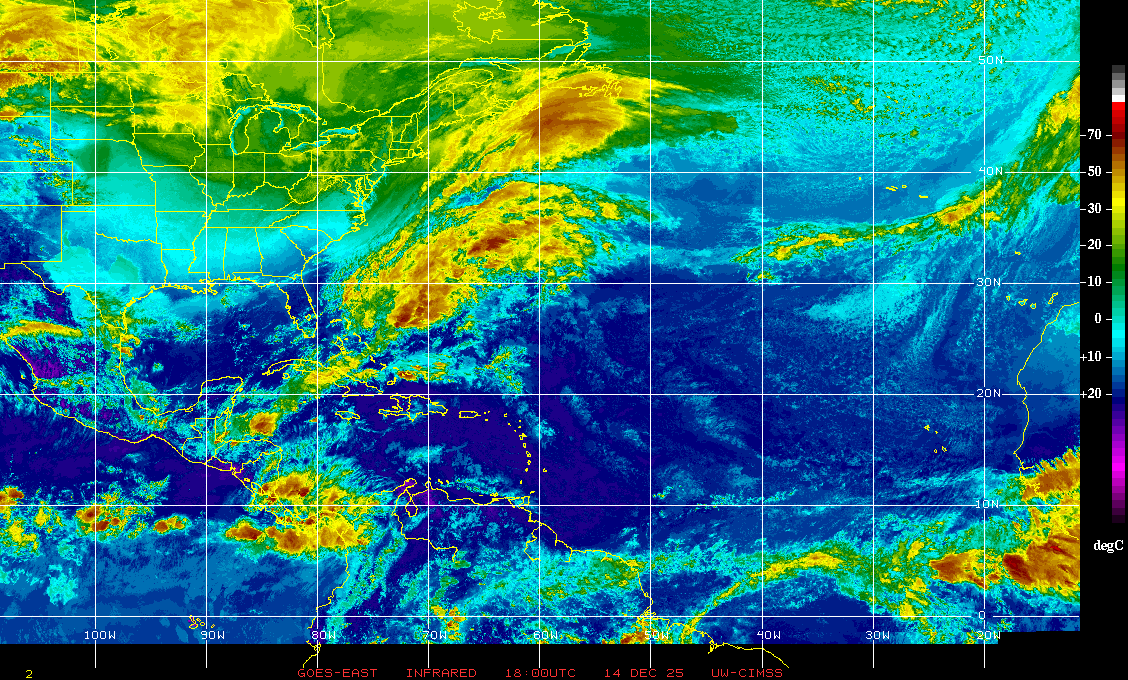Jacksonville, Fl. — The “Buresh Bottom Line”: Always be prepared!.....First Alert Hurricane Survival Guide... City of Jacksonville Preparedness Guide... Georgia Hurricane Guide.
STAY INFORMED: Get the * FREE * First Alert Weather app
FREE NEWS UPDATES, ALERTS: Action News Jax app for Apple | For Android
WATCH “Talking & Tracking the Tropics: The Science Behind the Season”
WATCH “Preparing for the Storm”
READ the First Alert Hurricane Center “Survival Guide”
***** ALWAYS CHECK & RE-CHECK THE LATEST FORECAST & UPDATES! *****
The Caribbean/Gulf of Mexico & SW Atlantic will remain the areas to keep an eye on over the next couple of weeks (climatologically favored too). However, there is nothing threatening through the upcoming weekend into early next week.
Big Picture:
The tropics are in their “percolating” stage as I like to call it. More or less a resting period with not a whole of “action”, at least in the short term. Next week the upper levels of the atmosphere will undergo a big change as a deep & strong trough of low pressure digs into the Central U.S. becoming the prominent “player” on the weather stage by next weekend. This trough will likely have a lot to say about where & how any tropical systems might move. So as quiet as the tropics are through this weekend, it appears it will be quite the opposite within a week or so.
The Areas to Watch:
(1) low pressure will be developing over the Central Atlantic through the weekend. This low will essentially meander as a nontropical low initially through early next week. As the low strengthens & starts to drift to some semblance of the west, the low is likely to take on tropical characteristics through next week. Eventually... the low should turn more northward over the West Atlantic staying east - as it would appear now - of the U.S. east coast but could become an “issue” for Bermuda by next weekend or the following week.
(2) The GFS model in particular.... & now most of the long range models - has been reasonably consistent in developing low pressure & an eventual tropical cyclone over the Caribbean that then moves north/northeast between Oct. 21 & 28th. Where the potential system would go & how strong it might be has varied considerably from one day to the next with a tendency to delay the development some. The Caribbean is an area favored for late season tropical development + the GFS has been decent at picking up on long range development this season (not necessarily the long term details/track). The European & UKMET at least indicate lower pressures but are otherwise - at least so far - not as aggressive on this potential feature.... & are also delaying what development they are showing. The latter is quite plausible (later/slower developing system). Since Thu., both the Euro & UKMET have become more emphatic about the Caribbean system which increases confidence - unfortunately - that we’ll have a late season development coming out of the Caribbean. This kind of set-up is notorious for slow development but once established, a strong tropical cyclone can evolve that then gets pulled north or northeast due to the farther south latitude jet stream (vs. earlier in the season, especially Aug./Sept.).
This is a heads-up & ‘First Alert’ for the Caribbean & Southeast U.S./Eastern Gulf regarding tropical “trouble” late next week/next weekend &/or possibly into the following week.
Where Atlantic tropical cyclones have formed mid to late Oct. since 1966, by Phil Klotzbach:




October tropical cyclone origin points are clustered over the Caribbean, Gulf of Mexico & SW Atlantic:
Atlantic Basin wave forecast for 24, 48 & 72 hours respectively (major wave action at Fl./Ga. beaches through early next week due to persistent brisk onshore flow (high pressure to the north) combined with easterly swells from distant Teddy:









:quality(70)/cloudfront-us-east-1.images.arcpublishing.com/cmg/WW5AJL3ARQUGDQMAQUNSFX4CLE.jpg)





















:quality(70)/cloudfront-us-east-1.images.arcpublishing.com/cmg/HJ3L3HBBJBH6PB5ZFB3SVGFXSU.png)
:quality(70)/cloudfront-us-east-1.images.arcpublishing.com/cmg/4TQDXERT5VGORNZ4NQWXNO5H64.png)
:quality(70)/cloudfront-us-east-1.images.arcpublishing.com/cmg/SKX4RKW645ERTATCLA4V2FVRKQ.png)
:quality(70)/cloudfront-us-east-1.images.arcpublishing.com/cmg/TYVIYUNT7BBHDLGYYWGCJB424E.png)
:quality(70)/cloudfront-us-east-1.images.arcpublishing.com/cmg/WYUHBF3SFRC7HITANNA24VG6DI.jpg)
:quality(70)/cloudfront-us-east-1.images.arcpublishing.com/cmg/V7JDMMD6JJEEHIL6C7OSLV3ABU.png)
:quality(70)/d1hfln2sfez66z.cloudfront.net/04-20-2024/t_50ad93a3ff19442c92d6e1ccd6123c3c_name_file_960x540_1200_v3_1_.jpg)
:quality(70)/cloudfront-us-east-1.images.arcpublishing.com/cmg/6JTO5NR7JDRXPV2PBS6QB44I6I.jpg)
:quality(70)/cloudfront-us-east-1.images.arcpublishing.com/cmg/C4YNDKMPQLYDRC5GYIRADT3CGY.jpg)
